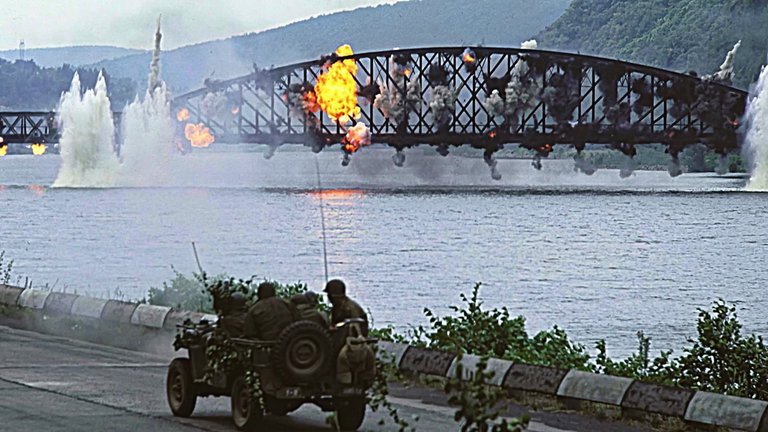
Hollywood’s role in shaping Cold War narratives is well-documented, from McCarthy-era propaganda to Reagan’s Star Wars rhetoric. Yet, if one were to pinpoint a film whose production inadvertently swayed Cold War dynamics, the answer might lie in an unlikely candidate: The Bridge at Remagen (1969). Directed by John Guillermin, this war epic—ostensibly a routine WWII action flick—became entangled in geopolitical tensions when its Czechoslovakian filming locations collided with the Prague Spring of 1968. While Hollywood’s cultural influence often bolstered American soft power, Remagen’s legacy is uniquely paradoxical: a film whose behind-the-scenes chaos arguably weakened Soviet credibility more than its on-screen explosions ever could .
The film adapts Ken Hechler’s 1957 book The Bridge at Remagen, a meticulously researched account of the Ludendorff Bridge’s capture in March 1945. Hechler, a U.S. Army veteran and historian, drew from firsthand interviews with soldiers to reconstruct the battle’s tactical nuances. His work not only immortalised the “Miracle of Remagen” but also funded his political ambitions: proceeds from the book financed his successful congressional campaign, and he later served as a technical advisor for the film .
Set in March 1945, the film opens with Allied forces breaching the Siegfried Line, poised to cross the Rhine—the last natural barrier into the heart of Nazi Germany. The Ludendorff Bridge at Remagen, inexplicably intact, becomes the focal point of a desperate tug-of-war. Robert Vaughn’s Major Paul Krueger, tasked with delaying its destruction to allow trapped German troops to retreat, faces a moral quagmire: obey orders or save lives. Across the Rhine, George Segal’s Lieutenant Phil Hartman leads a battered U.S. unit under Major Barnes (played by Bradford Dillman) to seize the bridge, despite General Shinner’s (played by E.G. Marshall) grim calculus: sacrifice hundreds to save thousands .
The narrative thrives on historical irony. German engineers’ use of industrial-grade explosives (instead of military-grade) and the bridge’s eventual collapse ten days post-capture are faithfully depicted, albeit compressed for dramatic effect . Yet, the film’s true tension lies in its portrayal of war’s futility—exhausted soldiers on both sides, aware of the war’s inevitable end, yet bound to bloody duty.
The film’s geopolitical significance stems from its fraught production. Seeking authenticity, producer David L. Wolper chose Most, a Czechoslovakian town slated for demolition, as the primary location. The decision to import surplus U.S. military equipment—including eight Sherman tanks and 1,000+ firearms—alarmed Soviet observers already wary of the Prague Spring’s liberal reforms. Warsaw Pact propaganda framed the production as a CIA-fronted coup, exploiting paranoia to justify their August 1968 invasion .
Though filming resumed in Italy and West Germany, the invasion’s fallout was irreversible. The crackdown shattered Czechoslovakia’s reformist momentum and exposed Soviet brutality, alienating Western leftists and hastening the ideological decay of Eastern Bloc communism. In a twist worthy of Orwell, Remagen—a film about WWII’s end—became a catalyst for Cold War realignment .
As a war spectacle, Remagen excels. Guillermin, fresh from The Blue Max (1966), marshals practical effects with grim efficiency: real tanks, pyrotechnics, and the demolition of Most’s streets create visceral chaos unmatched by CGI-laden contemporaries. Cinematographer Stanley Cortez’s sweeping shots of the bridge—a character in its own right—evoke both strategic urgency and symbolic fragility . The film’s aesthetic authenticity, however, is a double-edged sword. While the action sequences rival The Longest Day (1962), their reliance on real explosions and period-accurate weaponry (e.g., M24 Chaffee tanks, MG34 machine guns) often overshadows the human drama .
Where Remagen falters is in its emotional depth. Robert Vaughn’s Krueger, though nuanced, is hamstrung by clichéd dialogue—a “tragic Teuton” torn between honour and hopelessness. Similarly, George Segal’s Hartman embodies war-weariness but lacks dimensionality, reduced to a grimacing avatar of survival. Only Ben Gazzara’s Sergeant Angelo, a corpse-looting antihero, injects moral ambiguity, reflecting war’s dehumanising toll .The German defenders, portrayed as ageing conscripts and Hitler Youth, elicit unintended pathos. Yet, their underdog status undermines narrative stakes; with the war’s outcome certain, their defiance feels more futile than heroic .
The film’s token nod to exploitation cinema—a superfluous scene featuring Anna Gael as a French mistress disrobing—clashes tonally with its sombre themes. This jarring inclusion, likely a concession to 1960s box-office trends, undermines the story’s gravity, reducing Gael’s character to a narrative afterthought .
Premiering in 1969 amid Vietnam War protests, Remagen faced an unreceptive audience. Though screenwriters William Roberts and Richard Yates peppered the script with anti-war sentiment—e.g., American soldiers looting corpses, German civilians renouncing Nazism—these moments drown in relentless action. The film’s cynical ethos, akin to later New Hollywood works, failed to resonate with a generation rejecting militarism .
Financially, it flopped, grossing a meagre $3 million against its $6.5 million budget. Critics dismissed it as “competent but forgettable”—a verdict that persists today, despite reappraisals highlighting its historical significance .
The Bridge at Remagen is a cinematic paradox: a technically adept war film overshadowed by its own production’s Cold War ramifications. While its on-screen battles pale beside classics like Saving Private Ryan, its off-screen legacy—as an unwitting pawn in superpower brinksmanship—secures its place in history. For scholars, it offers a case study in art’s geopolitical ripple effects; for casual viewers, it remains a flawed yet fascinating relic of Hollywood’s martial nostalgia. In the end, the bridge that shortened WWII also, ironically, helped lengthen the Cold War’s twilight.
RATING: 5/10 (++)
Blog in Croatian https://draxblog.com
Blog in English https://draxreview.wordpress.com/
InLeo blog https://inleo.io/@drax.leo
Hiveonboard: https://hiveonboard.com?ref=drax
InLeo: https://inleo.io/signup?referral=drax.leo
Rising Star game: https://www.risingstargame.com?referrer=drax
1Inch: https://1inch.exchange/#/r/0x83823d8CCB74F828148258BB4457642124b1328e
BTC donations: 1EWxiMiP6iiG9rger3NuUSd6HByaxQWafG
ETH donations: 0xB305F144323b99e6f8b1d66f5D7DE78B498C32A7
BCH donations: qpvxw0jax79lhmvlgcldkzpqanf03r9cjv8y6gtmk9